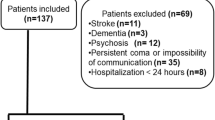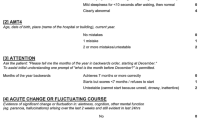Abstract
Objective
In the intensive care unit (ICU) we assessed the agreement between the delirium ratings of two independent delirium assessment methods: (a) the Confusion Assessment method for the ICU (CAM-ICU); and (b) the Intensive Care Delirium Screening Checklist (ICDSC).
Design
Prospective, descriptive cohort study.
Setting and patients
During a 6-month period, 174 patients (mean age 62.4 ± 13.0 years) admitted to the ICU after elective surgery or after an emergency were included and assessed with both delirium assessment systems by two trained independent investigators (research person and bedside nurses) during their ICU stay or for up to 7 days after ICU admission.
Interventions
Patients' clinical characteristics at ICU admission day were documented.
Measurements and results
After excluding permanently unconscious patients with ≤ –4 on the Richmond Agitation Sedations scale, delirium was identified in 71 of the 174 patients (41%). The patients who were included were tested in 374 paired but researcher-independent ratings of delirium by both scoring methods. The kappa coefficient determined over 7 days of ICU stay was 0.80 (CI 95%: 0.78–0.84; p < 0.001), indicating good agreement.
Conclusion
It is concluded from the present investigation that the two scoring methods represent good diagnostic tools with high agreement rates in critical ill ICU patients.
Similar content being viewed by others
References
Ely EW, Gautam S, Margolin R, Francis J, May L, Speroff T, Truman B, Dittus R, Bernard R, Inouye SK (2001) The impact of delirium in the intensive care unit on hospital length of stay. Intensive Care Med 27:1892–1900
Ely EW, Shintani A, Truman B, Speroff T, Gordon SM, Harrell FE Jr, Inouye SK, Bernard GR, Dittus RS (2004) Delirium as a predictor of mortality in mechanically ventilated patients in the intensive care unit. J Am Med Assoc 291:1753–1762
McNicoll L, Pisani MA, Zhang Y Ely EW, Siegel MD, Inouye SK (2003) Delirium in the intensive care unit: occurrence and clinical course in older persons. J Am Geriatr Soc 51:1–9
Wacker P, Nunes PV, Cabrita H, Forlenza OV (2006) Post-operative delirium is associated with poor cognitive outcome and dementia. Dement Geriatr Cogn Disord 21:221–227
Inouye SK, Rushing JT, Foreman MD, Palmer RM, Pompei P (1998) Does delirium contribute to poor hospital outcomes? A tree-site epidemiologic study. J Gen Intern Med 13:234–242
Diagnostic and statistical manual of mental disorders, 4th edn, revised (2000) American Psychiatric Association, Washington, DC
Pisani M, Inouye SK, McNicoll L, Redlich CA (2003) Screening for pre-existing cognitive impairment in older intensive care unit patients: use of proxy assessments. J Am Geriatr Soc 51:689–693
Neelon VJ, Champagne MT, Carlson JR, Funk SG (1996) The NEECHAM Confusion Scale: construction, validation, and clinical testing. Nurs Res 45:324–330
Hart RP, Levenson JL, Sessler CN, Best AM, Schwartz SM, Rutherford LE (1996) Validation of a cognitive test for delirium in medical ICU patients. Psychosomatics 37 45:324–330
Devlin JW, Fong JJ, Fraser GL, Riker RR (2007) Delirium assessment in the critically ill. Intensive Care Med 33:929–940
Ely EW, Inouye SK, Bernard GR Gordon S, Francis J, May L, Truman B, Speroff T, Gautam S, Margolin R, Hart RP, Dittus R (2001) Delirium in mechanically ventilated patients: validity and reliability of the confusion assessment method for the intensive care unit (CAM-ICU). J Am Med Assoc 286:2703–2710
Ely EW, Margolin R, Francis J, May L, Truman B, Dittus R, Speroff T, Gautam S, Bernard GR, Inouye SK (2001) Evaluation of delirium in critically ill patients: validation of the Confusion Assessment Method for the Intensive Care Unit (CAM-ICU). Crit Care Med 29:1370–1379
Inouye SK, van Dyck CH, Alessi CA Balkin S, Siegal AP, Horwitz RI (1990) Clarifying confusion: the Confusion Assessment Method. A new method for the detection of delirium. Ann Intern Med 113:941–948
Bergeron N, Dubois M-J, Dumont M, Dial S, Skrobnik Y (2001) Intensive care delirium screening checklist: evaluation of a new screening tool. Intensive Care Med 27:859–864
McNicoll L, Pisani MA, Ely EW, Gifford D, Inouye SK (2005) Detection of delirium in the intensive care unit: comparison of confusion assessment method for intensive care unit with confusion assessment method ratings. J Am Geriatr Soc 53:495–500
Lemiengre J, Nelis T, Joosten E, Braes T, Foreman M, Gastmans C, Milisen K (2006) Detection of delirium by bedside nurses using the confusion assessment method. J Am Geriatr Soc 54:685–689
Altman DG (1991) Practical statistics for medical research. Chapman and Hall, London
Bergeron N, Skrobnik Y, Dubois M-J (2002) Delirium in critically ill patients. Crit Care 6:181–183
Roberts B, Rickard CM, Rajbhandari D, Turner G, Clarke J, Hill D, Tauschke C, Chaboyer W (2005) Multicentre study of delirium in ICU patients using a simple screening tool. Australian Crit Care 18:6–16
Thomason JW, Shintani A, Peterson JF, Pun BT, Jackson JC, Ely EW (2005) Intensive care unit delirium is an independent predictor of longer hospital stay: a prospective analysis of 261 non-ventilated patients. Crit Care 9:R375–R381
Armstrong SC, Cozza KL, Watanabe KS (1997) The misdiagnosis of delirium. Psychosomatics 38:433–439
Ouimet S, Riker R, Bergeon N, Cossette M, Kavanagh B, Skrobik Y (2007) Subsyndromal delirium in the ICU: evidence for a disease spectrum. Intensive Care Med 33:1007–1013
Acknowledgements
This work was supported in part by the Else Kroener–Fresenius–Stiftung, Bad Homburg i. d. H., Germany. We thank M. Pritsch and P. Schiller from the Department of Biostatistics of the University of Heidelberg, and S. Haag, for productive discussions.
Author information
Authors and Affiliations
Corresponding author
Electronic supplementary material
Rights and permissions
About this article
Cite this article
Plaschke, K., von Haken, R., Scholz, M. et al. Comparison of the confusion assessment method for the intensive care unit (CAM-ICU) with the Intensive Care Delirium Screening Checklist (ICDSC) for delirium in critical care patients gives high agreement rate(s). Intensive Care Med 34, 431–436 (2008). https://doi.org/10.1007/s00134-007-0920-8
Received:
Accepted:
Published:
Issue Date:
DOI: https://doi.org/10.1007/s00134-007-0920-8




